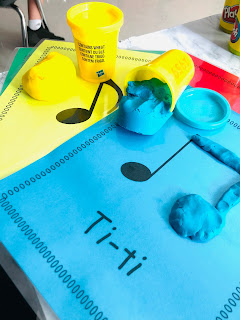Maybe we should call this Africa, round 1. If y'all are like me, you are constantly looking for creative ways to up your curriculum game. Anyway: here's what I have so far for my two week unit on African music.
Reminders:
I teach middle school students. I see them every day for about 50 minutes. The students have a pretty solid Orff background. My class is an elective, so students can choose the class, whether they are in other music ensembles or none at all. I focus on learning by doing, which means I teach many of my Orff pieces by rote rather than focus on note reading skills. This allows for more time to learn about the actual cultures and also puts all of my students (musical or not) on an even playing field. My class is not performance based. Our playing of instruments is for the purpose of learning about cultures and experiencing different types of music. I always let my kids know if they WANT to perform somewhere, I'll set it up. I don't MAKE my kids sing. If I teach a song, I welcome them to sing along if they want, but I also teach the melody on Orff instruments when accessible.
My general skeleton of my curriculum per global area includes:
1. CONCEPT: One composition or individual learning or research project
2. ORFF: A few options for Orff or Drum ensemble pieces that are culturally appropriate and authentic.
3. LISTEN AND LEARN: Supplemental learning, including videos of authentic performances, culturally relevant games, easy movement or dances, etc.
Okay. Africa.
CONCEPT: Box Notation for Drumming
I have a lot of resources to help me build this curriculum. One book already in my office was The New Conga Joy by Bill Matthews (I will link below) . I realize box notation isn't necessarily an authentic African notation system, but this book has authentic African and Afro-Caribbean rhythms set in this accessible notation. I like using this notation with my students because it puts ALL students on the same musical page. We are all learning this simple notation system together. The book uses 12-13 different symbols for each way to hit the drums. To simplify for my students, we learn several songs from the book that only use B (Bass), O (Tone) and a black dot (rest). I learned pretty quickly, if I wanted my students to make their own compositions, I should change the Bass to (L - Low), Tone to (H - High) and keep the rest. **If you don't know why I did that, just make a few of your own compositions using B and O, and you might figure out why pre-teens might be distracted by these letters.**
So, after we establish how to read a few of the compositions out of the book, I have students make their own. We do a few practice rounds together, then I give them this page and give them time to work on their own composition. We have enough tubanos for each student to use their own, but you could practice on smaller drums, and then perform on a bigger drum.
https://www.teacherspayteachers.com/Product/Box-Notation-Drum-Composition-7386477
The students are then graded, using a simple rubric (included in the TPT purchase). The rubric assesses whether the students used all three symbols, whether their performance matched their composition, and whether their performance was well practiced. Students could submit videos to me on their chromebooks, or perform live for me. At this point in the trimester, students feel safer performing just for me, and not in front of the whole class. I still give the brave students a chance to share with the class, if they want to.
ORFF: drumming or Orff ensemble pieces used
I choose 2-3 pieces from this list based on the overall ability of the group I have for the current trimester.
6th grade:
- pieces from Conga Joy (link below)
- Tue, Tue (Ghana), arranged by Shirley W. McRae, Sing 'Round The World (link below)
- Obiswana (Ghana), arranged by B. Thompson https://www.bethsnotesplus.com/
- Kebe Mama (Ghana) Arranged by Calla Isaak, African Rhythms and Beats (link below)
- Sansa Kroma (Ghana) (also in African Rhythms and Beats)
7th Grade:
- pieces from Conga Joy (link below)
- Polyrhythm, arranged by Jordan Hanson (also in African Rhythms and Beats)
- Tatenda, inspired by music from Zimbabwe, arranged by Walt Hampton, Marimba Mojo! (link below)
- Baba Mudiki (Zimbabwe), arranged by Paul Mataruse, African Marimba Vol. 1 by Bonnie Carol (link below)
- Kokoleoko (Liberia), arranged by B.Thompson, https://www.bethsnotesplus.com/
8th Grade:
- pieces from Conga Joy (link below)
- Buya IAfrica (Zulu), arranged by Ross Johnson and Bonnie Carol, African Marimba Vol. 1 by Bonnie Carol (link below)
- The Three Brothers Folktale and Kondo (Ghana), arranged by Calla Isaak, (also in African Rhythms and Beats)
- Eh Soom Boo Kawaya (Nigeria), arranged by B. Thompson https://www.bethsnotesplus.com/
- Kutenda (To Thank), Arr. Jane Lamb, (in Kutamba!, link below)
LISTEN AND LEARN: supplements to enhance learning
- Authentic YouTube videos of drum and instrument ensembles from Africa
- Instrument Classification Worksheet and Videos
Resources Referenced:
https://www.amazon.com/New-Conga-Joy-Bill-Matthews/dp/0971886105
https://www.amazon.com/Sing-Round-World-International-Folksongs/dp/0934017123
https://www.amazon.com/African-Rhythms-Beats-Traditions-Classroom/dp/188888519X
https://www.amazon.com/Marimba-mojo-Zimbabwean-style-pieces-instruments/dp/0937203866
https://www.amazon.com/African-Marimba-Vol-Beginning-Tunes/dp/0972110895
https://www.westmusic.com/search-results?q=kutumba









